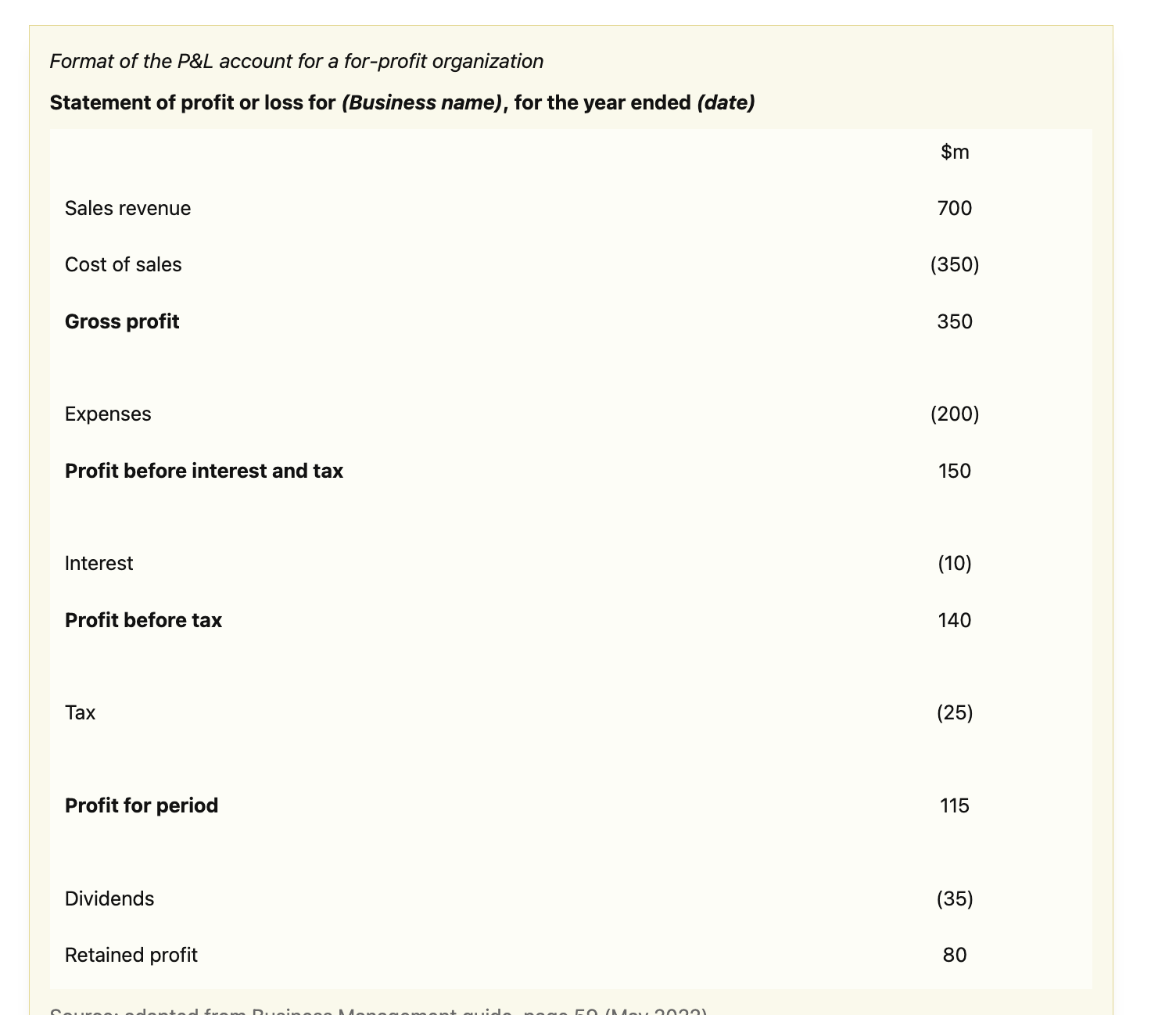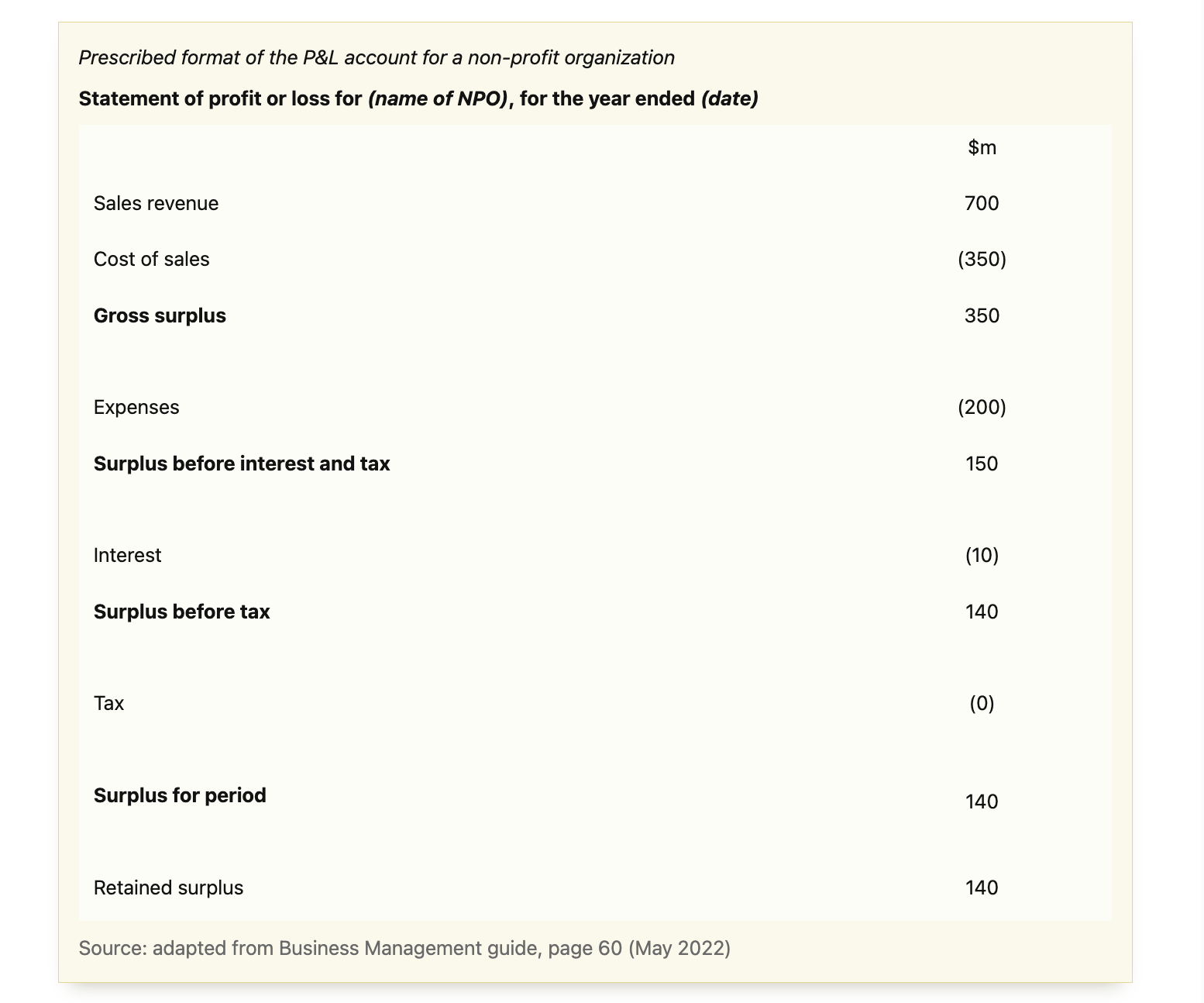❤️🔥 3.4 Final Accounts
1/70
There's no tags or description
Looks like no tags are added yet.
Name | Mastery | Learn | Test | Matching | Spaced |
|---|
No study sessions yet.
71 Terms
Final accounts
Published accounts of an organization, made available and used by different stakeholders.
Profit and loss account (income statement) and balance sheet (statement of financial position)
Importance to internal staeholders
Gauge performance of a business, to negotiate pay deals, or judge the level of job security.
Importance to external stakeholders
Make sensible and coherent decisions
Financiers - ability of an organization to afford its debts
Reasons why managers are interested in final accounts
Measure performance against organizational targets
Help with decision-making, sufficient funds for new projects?
Benchmark key indicators against competitors.
Reasons why employees are interested in final accounts
Gauge extent to which jobs are secure
Use final accounts in negotiation process with labour unions to discuss pay rises
Reasons why shareholders are interested in final accounts
Measure profitability and how this has changed over time
Determine how much dividends they receive
Compare financial performance of other businesses to make rational decisions - to buy or sell shares in the company.
Reasons why financiers are interested in final accounts
Decide whether to lend money and how much based on the level of risk
Check on the creditworthiness of the organization before loans are given
Assess extent to which a business is able to pay back its borrowing
Reasons why suppliers are interested in final accounts
Does the business have sufficient liquidity to pay its debt?
Gauge level of risk and creditworthiness.
Negotiate improved credit terms, extend trade credit period, or demand immediate cash payment.
Reasons why customers are interested in final accounts
Determine if the business offers security and reliability in its services
Determine whether there will be future supplies of the product they are purchasing
Is the business financially secure?
Working capital cycle
Lengthy delay between customers paying and receiving the products.
Reasons why governments or tax authorities are interested in final accounts
Verify amount of tax due to to be paid by the business
Ensure business operates within the law, adhering to accounting law and rules
Assess liquidity position of the business, threat of business closure, and extent to which this could cause economic problems (depends on the size and market of the business)
Reasons why competitors are interested in final accounts
Judge their financial performance by comparing their financial accounts with the business
Benchmark best practices by examining what the business does well, and determine how they themselves can improve.
Profit and loss account
Shows a firm’s profit or loss after all production costs have been subtracted from the organization’s revenues, each year.
Profit and loss account format

Sales revenue
Money an organization earns from selling goods and services.
Cost of sales (cost of goods sold)
Direct costs of production (raw materials or direct labor)
= Opening stock + Purchases - Closing Stock
Gross profit
Profit from everyday’s trading activities, calculated as Sales revenue - Cost of sales.
Measure of how much value is added in the production process
Expenses
Firm’s indirect costs of production
Profit before interest and tax
Value of a firm’s profit or loss before deducting interest payments on loans and taxes on corporate payments.
Profit for period
Actual value of profit (profit after interest and tax)
Tax
Compulsory deductions paid to the government as a proportion of a firm’s profits.
Dividends
Payments from a company’s profit (after interest and tax) paid to the shareholders of the company.
What determines amount of dividends paid?
Amount of dividends paid to shareholders is determined by BOD
Amount of dividends paid to an individual shareholder depends on number of shares held
Retained profit
Funds left over from profits that is not paid to shareholders is kept within the business for its own use
= Profit after interest and tax - dividends
Profit and loss account for a non-profit organization format
Any financial surplus is kept within the business, rather than distributed between shareholders
Lack of dividends for non-profit organizations

Balance sheet (statement of financial position)
Value of assets, liabilities, and the owner’s investment or equity at a particular point in time.
Reporting date is the same each year
Assets
Possessions of a business that have a monetary value, such as buildings and cash.
Liabilities
Debts of a business or money owed to others, such as trade creditors or financiers.
Balance sheet shows
Sources of finance: borrowed funds/liabilities, equity (investments of shareholders), and accumulated retained earnings.
Uses of finance: purchase of non-current assets and current assets
Format of balance sheet
Share capital is “Owner’s equity” for sole traders, partnerships, and non-profit business entities.
Retained earnings is used for both profit and non-profit organizations

Non-current assets
Long-term assets or possessions of an organization, not intended for resale within the next 12 months of the balance sheet date.
Accumulated depreciation
Sum of the fall in a non-current asset’s value due to wear and tear over time.
Illiquid assets
Items that cannot be sold quickly or are difficult to sell without in incurring a significant loss in value.
Current assets
Possessions with a monetary value, but liquidated within the next 12 months
Include cash, debtors, and stock
Cash
Money a business has in hand and/or at the bank
Most liquid current asset and easily accessible
Debtors
Individual or business customers that owe money to the business because they bought goods and services on trade credit
Stock (inventories)
Good available for sale, per time period and intended to be sold as quickly as possible to generate cash.
Categories of stock
Raw materials, work-in-progress or semi-finished goods, and finished goods.
Raw materials
Natural sources used in the production process.
Work-in-progress (semi-finished goods)
Components of a final product - items in the process of being produced to sell to customers.
Finished goods
Final products that are ready for sale and are of the most value to customers.
Total assets
Current assets + non-current assets.
Current liabilities
Short-term debts and repaid within 12 months.
Examples of current liabilities
Bank overdraft
Trade creditors (typically suppliers)
Short-term loans
Non-current liabilities
Long-term debts of a business, due after 12 months of the balance sheet date
Total liabilities
= Current liabilities + non-current liabilities
Net assets
Value of total assets after all liabilities have been deducted
= Total assets - total liabilities
Equity
Value of owner’s stake, comprised of share capital and retained earnings
Share capital
Value of equity in a business that is funded by shareholders, through an IPO or share issue
Retained earnings
Value of equity in a business that is funded by the accumulated profit after tax that has not been distributed as dividends to shareholders
= Opening retained earnings + Profit after interest and tax for current period - Dividends for current period
Balance balance sheet
Net assets = equity
Sources of finance = uses of finance
Examples of non-current liabilities
Bank loans
Borrow money at an agreed interest rate and repayment schedule
Mortgages
Long-term secured loans from commercial banks or financial lenders used to purchase property
Monthly payments are made, including interest
Corporate bonds
Debt securities (guarantees) sold to investors
Debt obligation that the borrower must repay with interest
Debentures
Long-term loans issued by organizations that borrow money from investors
Depend on creditworthiness, not specific assets
Intangible assets
Type of fixed asset except they are non-physical assets with a monetary value to the business, protected by using intellectual property rights.
Goodwill
Reputation and established networks (know-how) of an organization, adding significance above the market value of the firm’s physical assets
Helps to entice workers to the organization and to retain them.
Helps to attract investors.
However, the value of goodwill is subjective, so only materializes when the business is sold.
License
Gives business the legal right to operate in specific industries, use patented technology, sell particular products, or access certain resources.
Contribute to the organization’s operations and revenue generation.
Patents
Official rights given to a business to exploit an invention or process for commercial purposes.
Give a registered patent holder the exclusive right to use the innovation for a limited time period.
Creates incentive to invest in research and development and add value as the business can gain from having a unique selling point (USP).
Copyrights
Gives the registered owner the legal rights to creative pieces of work.
Exclusive rights to the commercial use of the product.
Trademarks
Form of IPP that give the owner exclusive commercial use of the registered brands, logos, and/or slogans.
Brand value
Expected earning potential of a brand (forecast future sales revenue). How much the brand is worth.
Depreciation
Fall in the value of a non-current asset. As it is used over and over, its value drops due to wear and tear (usage and natural ageing).
Residual value (scrap or salvage value)
Value of the non-current asset at the end of its useful life, before it is replaced.
Straight-line method
Spreads the depreciation evenly over the useful life of the non-current asset being depreciated. Value of the asset falls by equal amounts each year.
Book value
Value of the asset that is recorded in the balance sheet.
= Original cost of asset - Accumulated depreciation
Straight line method calculation
Annual depreciation = (Purchase cost - Residual value) / Estimated value lifespan
Advantages of straight line method
Ease of calculating depreciation, as the same amount is deducted each year. Depreciation is a fixed cost.
Suitable for assets that have a consistent usage rate.
Suitable for assets that have a known useful shelf-life and can be estimated.
Easier to make historical comparisons of the data.
Disadvantages of straight line method
Many non-current assets depreciate in value the most during the initial stages of their useful shelf life. Using a uniform depreciation may be misleading
Many assets do not depreciate consistently as they become less efficient over time.
Units of production method
Apportions an equivalent value of depreciation to a non-current asset based on each physical unit of output.
Method calculates depreciation based on the units of usagae rather than time.
Units of production rate (depreciation per unit)
= (Cost of asset - Salvage value) / Estimated units of production
Depreciation expense
= Units of production rate x Actual rate produced.
Advantages of units of production depreciation
More realistic to depreciate the value of an asset due to usage rather than the passing of time.
More accurate for non-current assets that depreciate directly due to wear and tear, rather than the passage of time.
Useful for manufacturers that experience fluctuations in production, based on changes in consumer demand over time.
Disadvantages of units of production depreciation
More complicated to calculate than the straight line method of depreciation.
Degree of subjectivity as the salvage value if subject to change and units of production is estimated.
Tax authorities do not allow this method, so it can only be used for internal bookeeping.